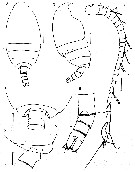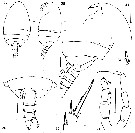|
|
 |
|
Calanoida ( Order ) |
|
|
|
Clausocalanoidea ( Superfamily ) |
|
|
|
Scolecitrichidae ( Family ) |
|
|
|
Plesioscolecithrix ( Genus ) |
|
|
| |
Plesioscolecithrix juhlae Markhaseva & Dahms, 2004 (F,M) | |
| | | | | | | Ref.: | | | Markhaseva & Dahms, 2004 (p.328, figs.F,M) |  issued from : E.L. Markhaseva & H.-U. Dahms in Sarsia, 2004, 89. [p.329, Figs.2-7]. Female (from Cape Norvegia, E Weddell Sea): 2-3, habitus (dorsal and lateral, respectively): 4-5, pedigerous somites 4-5 and genital double-somite (dorsal and right lateral, respectively); 6, urosome (dorsal); 7, A1. Scale bars: 0.2 mm (2, 3); 0.1 mm (4-7). Holotype (3-7; paratype (2). Nota ; Prosome 3.0-3.5 times as long as urosome. Cephalosome and pediger somite 1 fused, 4th and 5th separate. Rostrum well-developed bifurcated plate rami tapering into soft filaments. Genital double-somite in dorsal view barrel)shaped, symmetrical, supplied with round, black knob, which probably serves in closing the copulatory pore. Genital double-somite and urosomites 2 and 3 with thin denticles along the posterior margins. Anal somite well developed, slightly shorter than urosomite 3. Caudal rami symmetrical, with 6 setae (4 long thick distally, 1 dorsal and 1 ventral). A1 24-segmented, reaching the posterior part of pediger 3.
|
 issued from : E.L. Markhaseva & H.-U. Dahms in Sarsia, 2004, 89. [p.333, Figs.27-34]. Male: 27-28, habitus (dorsal and lateral, respectively); 29, forehead (lateral): 30-31, pedigerous somites 3-5 and urosome (dorsal and left lateral, respectively); 32, P4 ( terminal part of exopodite segment 3); 33, P5; 34, left P5 (exopodite segment 3). Scale bars: 0.2 mm (27, 28); 0.1 mm (other figures). Nota : Prosome 3.1 times as long as urosome.
| | | | | NZ: | 1 | | |
|
Distribution map of Plesioscolecithrix juhlae by geographical zones
|
| | | | | | | Loc: | | | Antarct. (E Weddell Sea: Cape Norvegia) | | | | N: | 1 | | | | Lg.: | | | (918) F: 1,7-1,74; M: 1,48; {F: 1,70-1,74; M: 1,48} | | | | Rem.: | hyperbenthic (benthopelagic); depths: 167-254 m.
For Markhaseva & Dahms (2004, p.335) this species (and genus) exhibits a combination of primitive and derived scolecitrichid characters. It is suggested that this one of the most primitive genera among the family Scolecitrichidae.
Plesiomorphic characters : 1- Pedigerous somites 4 and 5 are separated completely (female) or incompletely (males). In the major part of Scolecitrichidae they are fused (however in the type species of the family Sccolecithrix danae they are separated). 2- Male oral parts are not reduced in comparison with those of the female (and in this respect are like the Tharrybidae). Oral parts of scolecitrichid males are usually reduced. 3 – Mx2 proximal praecoxal endite with 5 setae. The scolecitrichids (except some species) typically have 3 (sometimes 4) setae. Mx2 brush)like sensory setae are small and thin with 4 very small brushes, that could be considered as an intermediate stage in the transformation from worm-like to brush-like setae (Nishida & Ohtsuka, 1997). 5- male p5 of simple structure ; coxo- and basipods are nearly symmetrical. In the majority of scolecitrichids, the basis of the right le gis strongly swollen and much shorter than that of the left, which is narrow and elongate (the most primitive scolecitrichid is described for Xantharus formosus Andronov, 1981 as biramous with 3 segmented exopods, 1-segmented endopods and nearly symmetrical coxo- and basipods).
Apomorphic characters : 1- Absence of P5 in female (this is atypical for the Scolecitichidae, but reported for species in some genera). 2- Presence of only 7 sensory setae on Mx2 exopod (plesiomorphic for Scolecitrichidae is apparently 9 setae). 3- P1 endopod proximal outer corner with a chitinuous loop, which is a thickening of the cuticle. 4- P1 endopod, P2 2nd endopodite segment and P3 3rd endopodite segment outer distal corners are produced into sharp protrusions identical in shape and development to that of Scolecithrix spp. (Park, 1983 ; Bradford & al., 1983). 5- Presence of 2 setae on the distal praecoxal lobe of Mxp syncoxa (the plesiomorphic state for scolecitrichids is 3 setae, observed for some species in different genera). | | | Last update : 28/12/2009 | |
|
|
 Any use of this site for a publication will be mentioned with the following reference : Any use of this site for a publication will be mentioned with the following reference :
Razouls C., Desreumaux N., Kouwenberg J. and de Bovée F., 2005-2025. - Biodiversity of Marine Planktonic Copepods (morphology, geographical distribution and biological data). Sorbonne University, CNRS. Available at http://copepodes.obs-banyuls.fr/en [Accessed December 31, 2025] © copyright 2005-2025 Sorbonne University, CNRS
|
|
 |
 |





